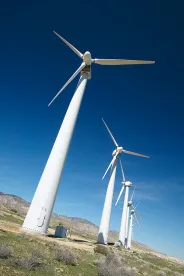Kenya is East Africa’s largest economy, yet it faces a power supply crisis. Per capita, it generates barely 4% of the power generated by South Africa. Only 18% of the population has access to electricity and, even for this fortunate minority, rationing and blackouts remain a daily reality.
The Kenyan Government has ambitious development goals for the country, seeking to achieve annual double-digit growth and to ‘create a prosperous and globally competitive nation with a high quality of life by the year 2030’. There is certainly plenty of cause for optimism. Politically, the country is relatively stable. The capital, Nairobi, is home to the regional offices of some of the world’s largest multinational corporations, including General Electric, Google and Coca Cola. These companies enjoy access to a labour force that is increasingly urbanised, professional, computer-literate and English-speaking.
However, the Kenyan Government recognises that the power problem is a very significant obstacle to its economic aspirations. For this reason, their ‘Vision 2030’ blue-print for economic development contemplates an additional 23 gigawatts of new installed capacity by 2030. With a currently generating capacity of only 1.5 gigawatts, it is a huge undertaking.
Lake Turkana Wind Power Project
It is against this backdrop that the signing of the financing documents for the Lake Turkana Wind Power Project took place in Nairobi in March this year. We advised Vestas Eastern Africa Limited throughout the development period. Vestas will supply and install 365 Vestas V52-850kW wind turbines at the site and provide long term maintenance of the turbines in contract with Lake Turkana Wind Power Limited.
The headline figures are remarkable and provide clear evidence of how seriously international developers and investors view the potential of the Kenyan energy market. When complete, Lake Turkana will provide 310 megawatts of reliable, low-cost, onshore wind power to the Kenyan national grid, equivalent to 20% of the current installed capacity. The capital cost of Ksh70 billion (€600 million) represents the single largest private investment in Kenya’s history.
In addition to the 365 wind turbines (each with a capacity of 850 kilowatts), the project will comprise an overhead electric grid collection system, a 428 kilometre transmission line and a high voltage substation. It will also include an upgrade of the existing road running from Laisamis, in Kenya’s Eastern Province, to Lake Turkana (a distance of 204 kilometres) and construction of a network of access roads in and around the site.
Challenges
The Lake Turkana project presents a unique set of challenges and, in our experience, is one of the most complex power projects ever to be brought to market.
The site for the wind farm was chosen, in large part, because of the strong and predictable winds known as the Turkana Corridor low level jet stream. However, Lake Turkana is also one of the most remote parts of Kenya. The isolated location gave rise to a patchwork of risks which needed to be addressed in the framework of contracts.
One key issue was the impact of the project on local communities. The stakeholders liaised extensively with the local population to ensure that they were comfortable with the arrangements for the construction and operation of the wind farm. Further key risks included transport risks (such as the poor state of existing road infrastructure and Somali piracy), the impact of the Kenyan rainy season, lack of water, power and other utilities necessary for large scale construction and risk to site personnel’s security.
In addition to the geographical factors, it is also worth noting that the project was procured via the multi-contract procurement structure more traditionally seen in onshore wind developments, rather than the increasingly common EPC ‘wrap’ structure generally favoured in project financed deals. The EPC ‘wrap’ has gained significant momentum as a result of the South African Government’s Renewable Energy Independent Power Producer Procurement Programme.
Towards a green economy?
With the first power scheduled to come online in early 2016, Lake Turkana has, in our view, set the benchmark for what is possible in the East African power market. As a feat of construction and engineering, the scale is remarkable. But more importantly, the fact that such a large and complex project has reached financial close will send a compelling message to the international power market about the role that renewable energy can play in Kenya’s development.
Kenya already has an impressive track record for small-scale hydroelectric power. However, due to its location, it also benefits from plentiful solar, geothermal and wind resources. As such, it represents an interesting opportunity for developers and investors alike. The closing of Lake Turkana may prove to be the catalyst for the Kenyan renewables sector so that it can play its part in delivering the Vision 2030.




 />i
/>i

